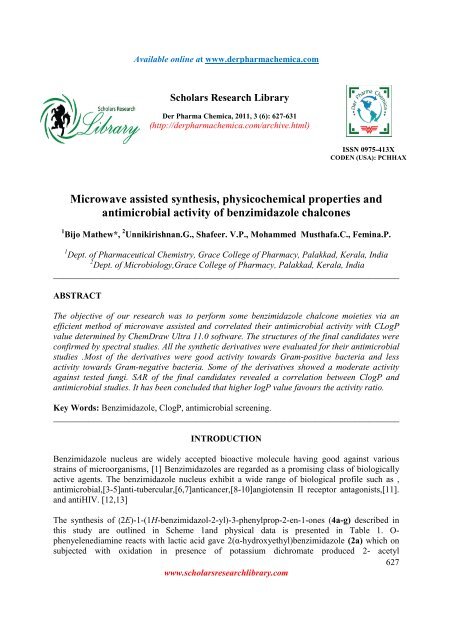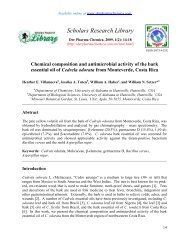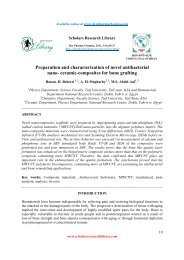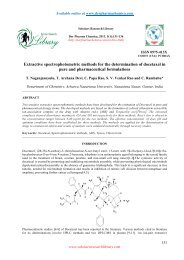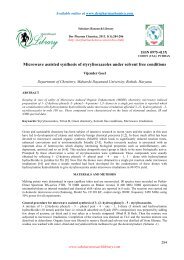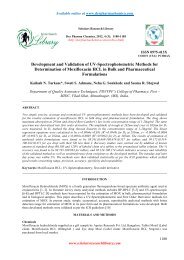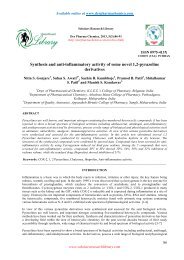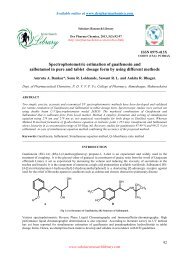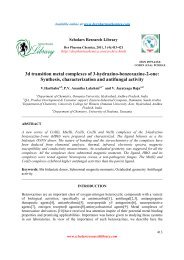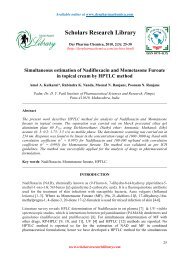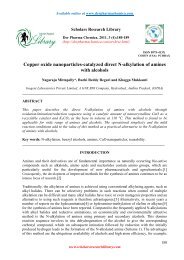Microwave assisted synthesis, physicochemical properties and ...
Microwave assisted synthesis, physicochemical properties and ...
Microwave assisted synthesis, physicochemical properties and ...
Create successful ePaper yourself
Turn your PDF publications into a flip-book with our unique Google optimized e-Paper software.
Available online at www.derpharmachemica.com<br />
Scholars Research Library<br />
Der Pharma Chemica, 2011, 3 (6): 627-631<br />
(http://derpharmachemica.com/archive.html)<br />
ISSN 0975-413X<br />
CODEN (USA): PCHHAX<br />
<strong>Microwave</strong> <strong>assisted</strong> <strong>synthesis</strong>, <strong>physicochemical</strong> <strong>properties</strong> <strong>and</strong><br />
antimicrobial activity of benzimidazole chalcones<br />
1 Bijo Mathew*, 2 Unnikirishnan.G., Shafeer. V.P., Mohammed Musthafa.C., Femina.P.<br />
1 Dept. of Pharmaceutical Chemistry, Grace College of Pharmacy, Palakkad, Kerala, India<br />
2 Dept. of Microbiology,Grace College of Pharmacy, Palakkad, Kerala, India<br />
______________________________________________________________________________<br />
ABSTRACT<br />
The objective of our research was to perform some benzimidazole chalcone moieties via an<br />
efficient method of microwave <strong>assisted</strong> <strong>and</strong> correlated their antimicrobial activity with CLogP<br />
value determined by ChemDraw Ultra 11.0 software. The structures of the final c<strong>and</strong>idates were<br />
confirmed by spectral studies. All the synthetic derivatives were evaluated for their antimicrobial<br />
studies .Most of the derivatives were good activity towards Gram-positive bacteria <strong>and</strong> less<br />
activity towards Gram-negative bacteria. Some of the derivatives showed a moderate activity<br />
against tested fungi. SAR of the final c<strong>and</strong>idates revealed a correlation between ClogP <strong>and</strong><br />
antimicrobial studies. It has been concluded that higher logP value favours the activity ratio.<br />
Key Words: Benzimidazole, ClogP, antimicrobial screening.<br />
______________________________________________________________________________<br />
INTRODUCTION<br />
Benzimidazole nucleus are widely accepted bioactive molecule having good against various<br />
strains of microorganisms, [1] Benzimidazoles are regarded as a promising class of biologically<br />
active agents. The benzimidazole nucleus exhibit a wide range of biological profile such as ,<br />
antimicrobial,[3-5]anti-tubercular,[6,7]anticancer,[8-10]angiotensin II receptor antagonists,[11].<br />
<strong>and</strong> antiHIV. [12,13]<br />
The <strong>synthesis</strong> of (2E)-1-(1H-benzimidazol-2-yl)-3-phenylprop-2-en-1-ones (4a-g) described in<br />
this study are outlined in Scheme 1<strong>and</strong> physical data is presented in Table 1. O-<br />
phenyelenediamine reacts with lactic acid gave 2(α-hydroxyethyl)benzimidazole (2a) which on<br />
subjected with oxidation in presence of potassium dichromate produced 2- acetyl<br />
627<br />
www.scholarsresearchlibrary.com
Bijo Mathew et al Der Pharma Chemica, 2011, 3 (6):627-631<br />
_____________________________________________________________________________<br />
benzimidazole(3a).The chalcones (4a–g) were prepared by reacting 2-acetyl benzimidazole with<br />
appropriate aldehydes in the presence of a base by Claisen-Schmidt condensation.<br />
MATERIALS AND METHODS<br />
All the chemicals <strong>and</strong> reagents used were of AR grade. Melting points were determined by using<br />
melting point apparatus MP-DS TID 2000 V <strong>and</strong> the values were uncorrected. Reactions were<br />
monitored by thin layer chromatography (TLC) on pre coated silica gel G plates using iodine<br />
vapour as visualizing agent.IR spectra were recorded on JASCO FT/IR-140 spectrophotometer<br />
by using KBr pellets technique.PMR spectra were recorded using BRUCKER FT-NMR-<br />
500MHz spectrophotometer by using DMSO as solvent <strong>and</strong> TMS as internal st<strong>and</strong>ard. The<br />
chemical shift was expressed in δ ppm. The <strong>physicochemical</strong> chemical <strong>properties</strong> like ClogP of<br />
the derivatives were calculated by ChemDraw Ultra 11.0 software.<br />
Micro wave <strong>assisted</strong> Synthesis of 2(α-hydroxyethyl) Benzimidazole. (2a)<br />
O-Phenyelenediamine (0.25 mol) was mixed with lactic acid (0.35 mol) in a beaker <strong>and</strong><br />
subjected to microwave oven at 40% power over a period of 4 minutes. The reaction mixture was<br />
cooled added with 10% NaOH until bacisity to litmus paper. The pink colured product obtained<br />
was thoroughly washed with water until it free from the added base in the product. The pale pink<br />
product obtained was dried over a hot air oven <strong>and</strong> recrystallized with hot water. The yield was<br />
found to be 88% [14] .<br />
Synthesis of 2- acetyl benzimidazole. (3a)<br />
To a solution of 2-(α-hydroxy) ethyl benzimidazole 2a (0.01 mol) in dil. H 2 SO 4 (5%, 40 ml) was<br />
drop wise added the solution of K 2 Cr 2 O 7 (0.15 mol) <strong>and</strong> H 2 SO 4 (25%, 80 ml) with constant<br />
stirring at room temperature over a period of 20 min. Further the reaction mixture was stirred at<br />
room temperature for 2 h. After completion of the reaction (monitored by TLC), the reaction<br />
mixture was neutralized with aqueous NH 3 solution (1:1) <strong>and</strong> resultant orange solid was filtered,<br />
washed with water <strong>and</strong> dried [15] .<br />
Micro wave <strong>assisted</strong> Synthesis of (2E)-1-(1H-benzimidazol-2-yl)-3-phenylprop-2-en-1-ones<br />
(4a-h)<br />
2-Acetyl benzimidazole (0.01 mol) is taken in 10ml of ethanol in a beaker <strong>and</strong> stir well. To this<br />
add 4ml of 40% KOH with aldehydes (0.012) .The whole mixture stirs vigorously for 20<br />
minutes. Then it becomes viscous <strong>and</strong> that subjected to microwave oven at 60% power over a<br />
period of 2-3minutes.The resultant product cooled <strong>and</strong> diluted with cold water <strong>and</strong> neutralized<br />
with dil.HCl [16] ..<br />
Characterization of the synthesized derivatives:<br />
4a:IR(KBr):3230(N-H str),1693(C=O),1587(C=N). 1 H NMR (DMSO-d6 +CDCl 3 ) in δ ppm:8.9<br />
(1H,s,NH benzimidazole), 7.2-7.9 (9H,m ArH),5.2-5.8( 2H,d,=CH-).<br />
4b:IR(KBr):3232(N-H str),1678(C=O),1581(C=N),771(Ar-Cl). 1 H NMR (DMSO-d6 +CDCl 3 ) in<br />
δ ppm:8.7 (1H,s,NH benzimidazole), 7.1-7.8(8H,m ArH),5.3-5.8( 2H,d,=CH-).<br />
www.scholarsresearchlibrary.com<br />
628
Bijo Mathew et al Der Pharma Chemica, 2011, 3 (6):627-631<br />
_____________________________________________________________________________<br />
4c:IR(KBr):3238(N-H str),1673(C=O),1577(C=N). 1 H NMR (DMSO-d6 +CDCl 3 ) in δ ppm:8.9<br />
(1H,s,NH benzimidazole), 7.3-7.8 (8H,m ArH),5.2-5.8( 2H,d,=CH-),3.3(3H,s,OCH 3 )<br />
4d:IR(KBr):3252(N-H str),1680(C=O),1592(C=N). 1 H NMR (DMSO-d6 +CDCl 3 ) in δ ppm:8.8<br />
(1H,s,NH benzimidazole), (8H,m ArH),5.2-5.8( 2H,d,=CH-)3.1(6H,s N(CH 3 ) 2<br />
4e:IR(KBr):3244(N-H str),1678(C=O),1567(C=N). 1 H NMR (DMSO-d6 +CDCl 3 ) in δ ppm:8.9<br />
(1H,s,NH benzimidazole), (8H,m ArH),5.4-6.1( 2H,d,=CH-).<br />
Table 1-Physical Data of the Synthesized Derivatives<br />
Compound Colour MW MP( 0 C) % Yield ClogP<br />
4a<br />
4b<br />
4c<br />
4d<br />
4e<br />
4f<br />
4g<br />
Brown<br />
Pale yellow<br />
Pale green<br />
Red<br />
Brown<br />
Pale yellow<br />
Brick red<br />
248<br />
282<br />
278<br />
291<br />
293<br />
264<br />
274<br />
246<br />
227<br />
230<br />
140<br />
262<br />
271<br />
138<br />
83<br />
92<br />
90<br />
81<br />
79<br />
69<br />
82<br />
3.27<br />
4.05<br />
3.32<br />
3.88<br />
2.85<br />
3.01<br />
3.82<br />
N H 2<br />
N H 2<br />
+<br />
C H 3<br />
O H<br />
40%MW<br />
3-4minutes<br />
COOH<br />
N<br />
N<br />
H<br />
O H<br />
C H 3<br />
2a<br />
H 2 SO 4<br />
K 2 Cr 2 O 7<br />
N<br />
O<br />
R -CHO<br />
10%KOH<br />
N<br />
O<br />
N<br />
H<br />
4a-g<br />
R<br />
60%MW<br />
2-3minutes<br />
N<br />
H<br />
R<br />
3a<br />
C H 3<br />
Scheme1<br />
4a: phenyl<br />
4b: 4- chloro phenyl<br />
4c: 4- methoxy phenyl<br />
4d: 4-dimethyl phenyl<br />
4e: 3- nitro phenyl<br />
4f: 2-hydroxy phenyl<br />
4g:cinnamyl<br />
Antimicrobial screening<br />
The antimicrobial screening of the synthesized derivatives were evaluated against two Grampositive<br />
bacteria viz., Bacillus subtilis, Staphylococcus aureus , two Gram-negaitive bacteria<br />
viz.,Escherichia coli ,Klebsiella pneumoniae <strong>and</strong> two fungi viz., C.albicans ,A.niger using<br />
streptomycin ,benzyl penicillin <strong>and</strong> amphoteracin B respectively as st<strong>and</strong>ard drugs respectively<br />
by the Cup-plate method using DMSO as the solvent [16,17] .The results were shown in table 2.<br />
www.scholarsresearchlibrary.com<br />
629
Bijo Mathew et al Der Pharma Chemica, 2011, 3 (6):627-631<br />
_____________________________________________________________________________<br />
Table 2: Antimicrobial screening of (4a-g)<br />
Zone of inhibition (mm)<br />
B. subtilis Staph. aureus E. coli K. pneumoniae C.albicans A.niger<br />
4a 10 11 06 08 - 02<br />
4b 11 12 10 09 03 -<br />
4c 13 15 6 09 - -<br />
4d 15 17 10 11 04 01<br />
4e 04 8 12 06 05 -<br />
4f 05 04 11 12 - 02<br />
4g 14<br />
Streptomycin - - 16 16 - -<br />
Benzyl Penicillin 18 17 - - - -<br />
Amphoteracin B - - - - 22 24<br />
RESULTS AND DISCUSSION<br />
Our research attempted a environment hazard free technique <strong>synthesis</strong> of 2E)-1-(1Hbenzimidazol-2-yl)-3-phenylprop-2-en-1-ones<br />
(4a-h) via microwave <strong>assisted</strong> method. All the<br />
final structures were confirmed by spectral analysis. By comparing the antimicrobial activity of<br />
the synthesized compounds,it was found that the test compounds are more active against Grampositive<br />
bacteria.It is believed that the strong lipophilic character of the molecule plays a crucial<br />
role in producing antimicrobial effect.The lipophilicity of the compounds expressed as logP,<br />
which explains the main predictor for the activity. Higher the value of calculated logP value<br />
favors for the activity.<br />
Acknowledgement<br />
Authors are highly thanksful Dr.Y.Haribabu, Principal, Grace College of Pharmacy, Palakkad,<br />
for supporting our research activities. Our thanks also goes to Dr.N.Muregeshan,IIT Chennai, for<br />
the spectral studies.<br />
REFERENCES<br />
[1] Yogendra KS, Jaynti R, Janardan Y, Ravindra K. Indian J Chem; 2010, 49B, 984-993.<br />
[2] Janardhana G, Khadar AMA, Kalluraya B,Kumari NS. Indian J Chem; 2010, 49B, 1130-<br />
1134.<br />
[3] Reddy VM, Reddy KR. Chem Pharm Bull; 2010, 58,953-956.<br />
[4] Desai KG, Desai KR. Bioorg Med Chem; 2006, 14, 8271-829.<br />
[5] Ansari KF, Lal C. Eur J Med Chem; 2009, 44, 2294-2299.<br />
[6] Jadhav GR, Shaikh MV, Kale RP, Shiradkar MR, Gill CH. Eur J Med Chem; 2009, 44,2930-<br />
2935.<br />
[7] Shingalapur RV, Hosamani KM, Keri RS. Eur J Med Chem; 2009, 44, 4244-4248.<br />
[8] Shaharyar M, Abdullah MM, Bakht MA, Majeed J. Eur J Med Chem; 2010,45,114-119.<br />
[9] Nofal ZM,Soliman EA, Elzahar MI,Srour AM, Sethumadhavan S, Maher TJ. Acta Polo<br />
Pharm Drug Res; 2011, 68,519-534.<br />
[10] Fadl TA, Elshorbagi AN,Hozien ZA, Wareth A ,Sarhan AO. Boll Chim Farmac Anno<br />
;2000,139,228-233.<br />
[11] Kaur N,Kaur A, Bansal Y,Shah DI,Bansal G,Singh M. Bioorg Med Chem; 2008,16,10210-<br />
10215.<br />
630<br />
www.scholarsresearchlibrary.com
Bijo Mathew et al Der Pharma Chemica, 2011, 3 (6):627-631<br />
_____________________________________________________________________________<br />
[12] Cheng J, Xie J, Luo X. Bioorg Med Chem Lett; 2005, 15,267-269.<br />
[13] Tewari AK, Mishra A. Indian J Chem; 2010, 45B, 489-493.<br />
[14] Kalirajan,Leela R,Jubie S,Gowramma B,Gomathy S,Sankar S,Elango K.Indian J Pharm<br />
Edu Res; 2010.44,358-362.<br />
[15] Reddy VM, Reddy KR.Chin Chem Lett; 2010, 21,1145-1148.<br />
[16] Bijo Mathew,MathewGE,MathewN,Vijayabhaskar. Der Pharma Chemica ; 2010,2(6),238-<br />
242.<br />
[17] Bijo Mathew, Suresh AJ,Mathew GE,Kumar SS,Shankar S. Int. J. Chem Tech Res; 2011,<br />
3(1),364-368.<br />
www.scholarsresearchlibrary.com<br />
631


